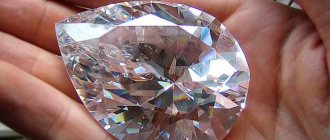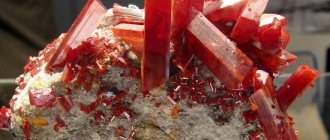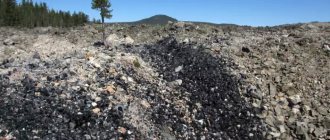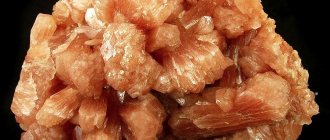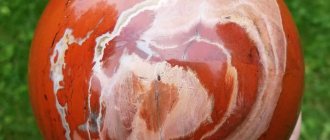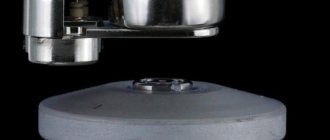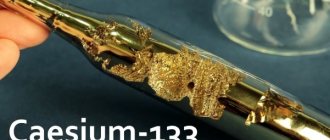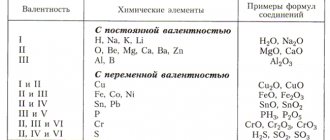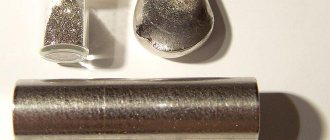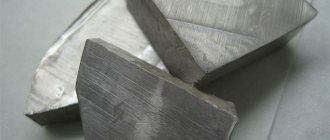Stone from the "High Hill"
This soft mineral with an earthy luster is widespread on our planet. But it was first discovered by the Chinese near a village located on a high gentle hill. The village was called Kao-Ling, which means “High Hill” in Chinese. By the way, this is where the term “clay” comes from. It is unknown when exactly the mineral kaolinite was discovered by the Chinese. However, Europeans learned about its existence only in the century before last.
You may be interested in: Method of strictly regulated exercise: essence, application, reviews
The mineral kaolinite belongs to the class of hydrous aluminum silicates. Its formula is as follows: Al4[Si4O10](OH)8. The chemical composition of kaolinite is as follows:
- Silicon dioxide – 47%.
- Aluminum oxide – 39%.
- Water – 14%.
It is necessary to distinguish between the concepts “kaolinite” and “kaolin”. The first is a mineral, and the second is a rock. Kaolinite is the main component of most clays.
Physical and chemical properties of the mineral
You may be interested in:Optical quantum generator device
Kaolinite, as we have already found out, is a clay mineral that in nature forms dense, finely dispersed geological masses. Let us list its main mechanical, physical and chemical properties and features:
- Hardness: 1.5-2 points (Mohs scale).
- Density: 2.6-2.7 g/cm3.
- Refractive index: 1.56.
- Luster: dull, earthy.
- Fracture: conchoidal.
- Mineral color: grayish, greenish, white, brown, pale yellow (thin scales may have a pearlescent tint).
- Trait color: white.
- The mineral kaolinite crystallizes in the triclinic system.
- The piece is opaque, but individual plates are translucent.
- To the touch - greasy.
- Absorbs moisture well.
- When heated to 500 degrees, it loses water, and at 1000-1200 degrees it disintegrates with the release of heat.
- Dissolves in sulfuric acid.
What is kaolinite and kaolin
Kaolinite is a mineral containing feldspar. When rock is processed, white clay (kaolin) is obtained.
Description of clay rock:
| Kaolinite | Kaolin (raw) |
| Clayey loose stone with a Mohs hardness of 2–2.5 points | A dusty rock that is white, gray, cream, or other light colored |
| The color is white, with a transition to yellow, cream, green, blue or red. There are brown spots | The deposit consists of a solid massif |
| The shine is dull, with a pearlescent tint | When moistened, it becomes slimy, plastic, soft |
| Opaque, thin plates show through under directional lighting | Splinters or rubs with slight pressure or impact |
| The break is uneven | May include sand grains or carbonate particles |
The name “kaolin” comes from the name of the territory in China - Gaoling District (High Mountain). Kaolinite continues to be mined here.
There are large kaolin deposits in the territories of Ukraine and Russia. The famous quarries are the Zhuravliny Log and the Kyshtymskoye deposits.
See the review of the mineral:
Deposits and production
Kaolinites occur both within the continental part of the earth's crust and in the zone of the ocean floor. The mineral is formed through a process called kaolinization, which is accompanied by chemical weathering and hydrothermal alteration of feldspars and other silicates.
The mineral kaolinite is found in various clays, marls and shales. Its largest deposits are located in the southeastern part of China. High-quality kaolins are also mined in Russia (Ural), Ukraine (Zhitomir, Kiev and Ternopil regions), Great Britain (Cornwell), Germany (Meissen, Halle), Czech Republic (Sedlce), Uzbekistan, Kazakhstan and Bulgaria.
It is worth noting that the process of extracting kaolins from the earth’s crust is not particularly expensive. They are mined mainly by open-pit (quarry) method. For example, this is what a clay quarry looks like in Ukraine (the city of Terebovlya, Ternopil region):
But this is the appearance (photo below) of already mined and crushed kaolinite in Spain.
Synthesis and genesis[edit]
Problems arise when attempting to explain the formation of kaolinite under atmospheric conditions by extrapolating thermodynamic data from more successful high-temperature syntheses (as pointed out, for example, by Meijer and Van der Plas, 1980 [21]). La Iglesia and Van Oosterwijk-Gastusch (1978) [22] believed that the conditions under which kaolinite would nucleate could be inferred from stability diagrams based on dissolution data. However, due to the lack of conclusive results in their experiments, La Iglesia and Van Oosterwijk-Gastusch (1978) concluded that there are other, as yet unknown, factors involved in the low-temperature nucleation of kaolinite. Because of the observed very slow rates of crystallization of kaolinite from solution at room temperature, Fripiat and Guerbillon (1971) postulated the existence of high activation energies for low-temperature nucleation of kaolinite.
At high temperatures, equilibrium thermodynamic models appear to be satisfactory for describing the dissolution and nucleation of kaolinite, since thermal energy is sufficient to overcome the energy barriers involved in the nucleation process. The importance of syntheses at ambient temperature and atmospheric pressure for understanding the mechanism involved in the nucleation of clay minerals lies in overcoming these energetic barriers. As pointed out by Caillère and Hénin (1960) [23], the processes involved must be studied in well-defined experiments because it is virtually impossible to isolate the factors involved by simple inference from complex natural physicochemical systems such as the soil environment. Fripiat and Guerbillon (1971) [24], in a review of kaolinite formation, raised the fundamental question of how disordered material (i.e. the amorphous fraction of tropical soils) can be transformed into a corresponding ordered structure. This transformation appears to occur in soils without major changes in the environment, over a relatively short period of time and at ambient temperatures (and pressures).
Low-temperature synthesis of clay minerals (using the example of kaolinite) has several aspects. First, the silicic acid supplied to the growing crystal must be in monomeric form, i.e., the silica must be present in a very dilute solution (Caillère et al., 1957; [25] Caillère and Hénin, 1960; [23] Wey and Siffert, 1962; [26] Millot, 1970 [27]). In order to prevent the formation of amorphous silicate gels that precipitate from supersaturated solutions without reacting with aluminum or magnesium cations to form crystalline silicates, the silicic acid must be present in concentrations below the maximum solubility of amorphous silica. The principle behind this premise can be found in structural chemistry: "Because polysilicate ions are not uniform in size, they cannot arrange themselves with metal ions into a regular crystal lattice." (Iler, 1955, p. 182[28]).
The second aspect of low-temperature kaolinite synthesis is that the aluminum cations must be hexacoordinated to oxygen (Caillère and Hénin, 1947; [29] Caillère et al., 1953; [30] Hénin and Robichet, 1955 [31]). Gastuche et al. (1962), [32] and Caillère and Hénin (1962) concluded that only when the aluminum hydroxide is in the form of gibbsite can kaolinite ever form. Otherwise, the resulting precipitate will be a “mixed aluminosilicate gel” (as expressed by Millot, 1970, p. 343). If this were the only requirement, large quantities of kaolinite could be collected simply by adding gibbsite powder to the silica solution. Undoubtedly, a noticeable degree of adsorption of silica in solution by the gibbsite surface will occur, but, as stated earlier, simple adsorption does not create a lattice of layers typical of kaolinite crystals.
The third aspect is that these two starting components must be included in the same mixed crystal with a layered structure. From the following equation (given by Gastuche and DeKimpe, 1962) [33] for the formation of kaolinite
2 Al ( OH ) 3 + 2 H 4 SiO 4 ⟶ Si 2 O 5 ⋅ 2 Al ( OH ) 3 + 5 H 2 O {\displaystyle {\ce {2Al(OH)3 + 2H4SiO4 -> Si2O5 . 2Al(OH)3 + 5H2O}}}
it can be seen that for every kaolinite molecule formed, five water molecules must be removed from the reaction. Field evidence illustrating the importance of removing water from the kaolinite reaction was provided by Gastuche and DeKimpe (1962). While studying soil formation on basaltic rock in Kivu (Zaire), they noted how the occurrence of kaolinite depended on the "degree of drainage" of the area in question. A clear difference was found between areas with good drainage (i.e. an area with a noticeable difference between wet and dry seasons) and those areas with poor drainage (i.e. permanently wetlands). Kaolinite was found only in areas with a distinct seasonal pattern of wet and dry. The possible significance of alternating wet and dry conditions during the transition of allophane to kaolinite was emphasized by Tamura and Jackson (1953). [34] The role of alternating wetting and drying on the formation of kaolinite was also noted by Moore (1964). [35]
Laboratory syntheses[edit]
Syntheses of kaolinite at high temperatures (over 100 °C [212 °F]) are relatively well known. There are, for example, syntheses by Van Nieuwenbergh and Pieterse (1929); [36] Knoll (1934); [37] Knoll (1936); [38] Norton (1939); [39] Roy and Osborne (1954); [40] Roy (1961); [41] Hawkins and Roy (1962); [42] Tomura et al. (1985); [43] Satokawa et al. (1994) [44] and Huertas et al. (1999). [45] Relatively few low-temperature syntheses have become known (see Brindley and DeKimp (1961); [46] DeKimp (1969); [47] Bogatyrev et al. (1997). [48]).
Laboratory synthesis of kaolinite at room temperature and atmospheric pressure was described by DeKimpe et al. (1961). [49] From these tests the role of periodicity becomes convincingly clear. DeKimpe et al. (1961) used daily supplements of alumina (as AlCl3·6H2O) and silica (as ethyl silicate) for at least two months. In addition, pH adjustment occurred every day by adding hydrochloric acid or sodium hydroxide. Such daily additions of Si and Al to the solution, combined with daily titration with hydrochloric acid or sodium hydroxide for at least 60 days, will introduce the necessary element of periodicity. Only now is the real role of what has been described as "aging" ( Alterung
) amorphous aluminosilicates (as, for example, Harder, 1978 [50]) noted) can be fully understood. Time as such does not cause any changes in a closed system that is in a state of equilibrium; but a series of alternating periodically changing conditions (by definition occurring in an open system) will result in the low-temperature formation of more and more of the stable kaolinite phase instead of the (ill-defined) amorphous aluminosilicates. .
History of the use of the mineral
As mentioned above, there is no information about how long ago the Chinese discovered kaolinite. But they were the first to do it. At least this is evidenced by the highest quality of ancient Chinese porcelain. Back in the third century BC, Chinese craftsmen created their unique “Terracotta Army”, consisting of eight thousand clay statues of warriors and horses.
The technology of processing kaolinite into “white gold” was kept secret by the masters of the Middle Kingdom for a long time. In Western Europe and Russia, they learned to make porcelain only in the 18th century. The first factories sprang up in Meissen, Germany, and Sèvres, France. In 1744, the Imperial Porcelain Factory was founded in St. Petersburg, operating to this day.
Mineral kaolinite: application today
It is not difficult to guess that the main consumer of this mineral is the porcelain and ceramics industry. It is worth noting that making high-quality porcelain is a rather complex and troublesome process. Fortunately, the stone itself is not rare and is easy to obtain. Porcelain is made from purified kaolinite. It is first removed from various impurities in centrifuges and hydrocyclones. After this, the raw materials are dehydrated in order to reduce weight and increase the strength of the final product.
In addition, the mineral kaolinite is also used in the production of coated paper, artistic glaze, and toothpaste. Industrial filters, electrical insulating gaskets, and thermal insulation materials are made from kaolin wool. Plus, kaolins (white clay) are widely used in cosmetology and folk medicine. Thus, the volumes of kaolinite consumption in the modern world are quite substantial.
Main varieties of mineral
In fact, by kaolinite, geologists mean a fairly large group of different minerals. The most common among them are:
- Rodalite.
- Terratolite.
- Keffekelit.
Rodalite is a mineral with a pink tint due to iron impurities. Mined in Northern Ireland. Terratolite is a mixture of quartz, mica, limonite and, in fact, kaolinite. The color of the mineral is blue-violet. Keffekelite contains impurities of halloysite and some other clay minerals and is distinguished by greenish-yellow tints. In China there are also deposits where a mixture of kaolinite with dickite, quartz and cinnabar is mined. This mineral has a specific name - “chicken blood”.
It would be worth noting that some varieties of kaolinite are quite beautiful. Therefore, they are actively used in decorating furniture and inlaying jewelry.
Links[edit]
Quotes [edit]
- ^ ab "Kaolinite Minerals Information and Data". MinDat.org. Retrieved August 5, 2009.
- "Kaolinite Mineral Data". McDougall Minerals
. Retrieved August 5, 2009. - ^ab Anthony J.W., Bidot R.A., Blood K.V., et al., eds. (1995). "Kaolinite" (PDF). Handbook of Mineralogy: Silica, Silicates
. Tucson, AZ: Mineral Data Publishing. ISBN 9780962209734. OCLC 928816381. - "kaolinite" Dictionary.com No abbreviations
. Random House. - "Kaolinite". Oxford Dictionaries
(online). January 20, 2016 - Stag WA, Howie RA, Zusman J (1992). Introduction to Rock Forming Minerals
(2nd ed.). Harlow: Longman. ISBN 9780470218099. - Pohl W. L. (2011). Economic Geology: Principles and Practice: Metals, Minerals, Coal and Hydrocarbons - An Introduction to the Formation and Sustainable Exploitation of Mineral Deposits. Chichester, West Sussex: Wiley-Blackwell. item 331. ISBN. 9781444336627.
- ↑ ab Schroeder PA (July 31, 2022). "Kaolin". Encyclopedia of New Georgia
(online). Retrieved March 14, 2022. - Harper, Douglas. "kaolin" Online Dictionary of Etymology
. - Perry D. L. (2011). Handbook of Inorganic Compounds
(2nd ed.). Boca Raton: Taylor & Francis. ISBN 9781439814611. OCLC 587104373. - ^ ab Nesse, William D. (2000). Introduction to Mineralogy
. New York: Oxford University Press. pp. 254–255. ISBN 9780195106916. - Jump up
↑ Breuer, Stephen (July 2012).
"The Chemistry of Pottery" (PDF). Chemistry Education
: 17–20. Retrieved December 8, 2022. - ^ a b Bellotto M., Gualtieri A, Artioli G. et al. (1995). “Kinetic study of the sequence of kaolinite-mullite reactions. Part I: dehydroxylation of kaolinite." Phys. Chem. Miner. 22
(4): 207–214. Bibcode: 1995PCM…. 22..207B. DOI: 10.1007/BF00202253. S2CID 95897543. - Migon P, Lidmar-Bergström K (2002). "Deep weathering through time in Central and Northwestern Europe: problems in dating and interpretation of the geological record." Catena
.
49
(1–2): 25–40. DOI: 10.1016/S0341-8162(02)00015-2. - Jump up ↑
Young A (1980).
Tropical Soils and Soil Surveying
.
Cambridge Geographical Studies. 9
. CUP Archive. paragraph 132. ISBN 9780521297684. - "Kaolin Capital of the World". City of Sandersville, Georgia
. Retrieved August 27, 2022. - Rhys K. "Coming to terms with the age-old practice of eating white dirt". Bitter Southerner
. Retrieved August 27, 2022. - Dushit, Ronald (December 12, 1987). "White St. George's clay turns into money". New York Times
. Retrieved January 19, 2022. - Virta R (2012). Mineral Commodity Summary (PDF) (Technical Report). US Geological Survey. pp. 44–45.
- Adatte T, Khozyem N, Spangenberg JE, et al. (2014). "Terrestrial environmental response to the Paleocene-Eocene Thermal Maximum (PETM), new insights from India and northeastern Spain". Rendiconti Online della Società Geologica Italiana
.
31
: 5–6. DOI: 10.3301/ROL.2014.17. - Meyer EL, van der Plas L (1980). Relative stability of soil minerals. Mededelingen Landbouwhogeschool Wageningen. 80
. Wageningen: Winman. paragraph 18. - La Iglesia A, Van Oosterwyck-Gastuche MC (1978). "Synthesis of kaolinite. I. Crystallization conditions at low temperatures and calculation of thermodynamic equilibria. Application to laboratory and field observations". Clays and clay minerals
.
26
(6):397–408. Bibcode: 1978CCM…. 26..397L. DOI: 10.1346/CCMN.1978.0260603. - ^ ab Caillère S, Hénin S (1960). "Vues d'ensemble for problems of the synthesis of mineralo argileux à basse température". Bulletin du Groupe français des argiles
(in French).
12
(7): 63. DOI: 10.3406/argil.1960.969. - Fripiat JJ, Herbillon AJ (1971). "Formation and transformation of clay minerals in tropical soils". Soils and tropical weathering: Proceedings of the Bandung Symposium 16 to 23 November 1969
.
Natural resources research. eleven
. Paris: UNESCO. pp. 15–24. OCLC 421565. - Caillere S, Henin S, Esquevin J (1957). "Synthèse des minéraux argileux." Bulletin du Groupe français des argiles
(in French).
9
(4): 67–76. DOI: 10.3406/argil.1957.940. - Way R, Sifferts W (1961). "Reactions of monomolecular silicon in solutions with Al3 + and Mg2 + ions." Colloques Internationaux
(in French).
National Center for Scientific Research. 105
: 11–23. - Millot G (1970). Geology of Clays
. Translation: Paquet H., Farran V.R. New York: Springer-Verlag. DOI: 10.1007/978-3-662-41609-9. ISBN 9783662416099. - Iler RK (1955). Colloidal chemistry of silica and silicates
. Ithaca, NY: Cornell University Press. - Caillere S, S Henin (1947). "Formation of a unique kaolin-type phyllite with the addition of monRecherches sur la synthèse des minéraux argileux." Bulletin de la Société française de Minéralogie et de Cristallographie
(in French).
76
(7): 300–314. DOI: 10.3406/bulmi.1953.4841. - Henin S, Robichet O (1955). "Résultats obtenus au cours de nouveaux essais de synthèse de minéraux argileux." Bulletin du Groupe français des argiles
(in French).
6
(1): 19–22. DOI: 10.3406/argil.1955.1257. - Gastuche MS, Fripiat JJ, DeKimpe S (1962). “La genèse des minéraux argileux de la famille du kaolin. I. — Colloidal aspect.” Spoken CNRS
.
105
: 57–65. - Gastuche MS, DeKimpe S (1962). “La genèse des minéraux argileux de la famille du kaolin. II. Aspect cristallin.” Spoken CNRS
.
105
: 75–88. - Jump up
↑ Tamura T, Jackson ML (1953).
"Structural and energetic relationships in the formation of oxides, hydroxides and silicates of iron and aluminum." The science
.
117
(3041):381–383. Bibcode: 1953Sci…117..381T. DOI: 10.1126/science.117.3041.381. PMID 17749950. - Moore L. R. (1964). "Formation and development of some kaolinite macrocrystals in situ". Clay minerals
.
5
(31): 338–352. Bibcode: 1964ClMin…5..338M. DOI: 10.1180/claymin.1964.005.31.02. - van Nieuwenburgh CJ, Pieterse HA (1929). "Studies on hydrated aluminum silicates: I. Rehydration of metakaolin and synthesis of kaolin." Rekl. Trav. Chim. Pays-Bas
.
48
(1):27–36. DOI: 10.1002/recl.19290480106. - Knoll W (1934). "Hydrothermale Synthese des Kaolins". Zeitschrift für Kristallographie, Mineralogie und Petrographie
(in German).
45
(2–3): 175–190. Authorization code: 1934ZKMP…45..175N. DOI: 10.1007/BF02943371. S2CID 96869398. - Knoll W (1936). “Über die Bildungsbedingungen von Kaolin, Montmorillonit, Sericit, Pyrophyllit und Analcim.” Zeitschrift für Kristallographie, Mineralogie und Petrographie
(in German).
48
(3–4): 210–247. Bibcode: 1936ZKMP…48..210N. DOI: 10.1007/BF02939458. S2CID 128744123. - Norton FH (1939). "Hydrothermal formation of clay minerals in the laboratory". I am. Mineral. 24
(1): 1–17. - Roy R, Osborne EF (1954). "Al2O3-SiO2-H2O system". Am. Mineral. 39
(11–12): 853–885. - Roy R (1962). "Preparation and properties of synthetic clay minerals". Spoken CNRS
.
105
: 83–98. - Jump up
↑ Hawkins DB, Roy R (1962).
"Electrolytic synthesis of kaolinite under hydrothermal conditions". Jam. Ceram. Soc. 45
(10): 507–508. DOI: 10.1111/j.1151-2916.1962.tb11044.x. - Tomura S, Shibasaki Y, Mizuta N, et al. (1985). "Growth conditions and genesis of spherical and lamellar kaolinite". Clays and clay minerals
.
33
(3):200–206. Bibcode: 1985CCM…. 33..200T. DOI: 10.1346/CCMN.1985.0330305. - Satokawa S., Osaki Y., Samejima S. et al. (1994). "Effect of silica-alumina gel structure on hydrothermal synthesis of kaolinite". Clays and clay minerals
.
42
(3):288–297. Bibcode: 1994CCM…. 42..288S . DOI: 10.1346/CCMN.1994.0420307. - Huertas FJ, Fiore S, Huertas F et al (1999). "Experimental study of hydrothermal formation of kaolinite". Chemical Geology
.
156
(1–4): 171–190. Bibcode: 1999ChGeo.156..171H. DOI: 10.1016/S0009-2541 (98) 00180-6. - Brindley GW, De Kimpe C (1961). "Attempts at low-temperature synthesis of kaolin minerals". Nature
.
190
(4772): 254. Bibcode: 1961Natur.190..254B. DOI: 10.1038/190254a0. S2CID 4149442. - De Kimpe C. R. (1969). "Crystallization of kaolinite at low temperature from aluminum-silicon gel". Clays and clay minerals
.
17
(1): 37–38. Bibcode: 1969CCM…. 17...37D. DOI: 10.1346/CCMN.1969.0170107. - Bogatyrev B.A., Mateeva L.A., Zhukov V.V. et al. (1997). "Low-temperature synthesis of kaolinite and halloysite on the gibbsite - silicic acid solution." Proceedings (Reports) of the Russian Academy of Sciences
. Sections of Earth Sciences. 353 A: 403–405. - DeKimpe CR, Gastuche MS, Brindley GW (1961). "Ionic coordination in aluminosilicic acids in relation to the formation of clay minerals" (PDF). I am. Mineral. 46
(11–12): 1370–1381. - Jump up
↑ Harder H (1978).
"Synthesen von Tonmineralen unter spezieller Berücksichtigung festländischer Bedingungen." Schriftenreihe für geologische Wissenschaften (Berlin)
(in German).
11
: 51–78. - Murray HH, Lyon SC (1955). "Relationship between the quality of paper coating and the degree of crystalline perfection of kaolinite". Clays and clay minerals
.
4
(1): 31–40. Bibcode: 1955CCM…..4…31M. DOI: 10.1346/CCMN.1955.0040105. - ↑
Rowe A (April 24, 2008).
"Nanoparticles Help Gauze Stop Bleeding Wounds". Wired
. Condé Nast. Archived from the original on July 6, 2009. Retrieved August 5, 2009. - "Stokoderm Protect PURE" (PDF). debgroup.com
(product brochure). Deb USA, Inc. 2022. Retrieved April 12, 2018. - Ciullo P. A. (1996). Industrial Minerals and Their Uses: A Directory and Formulary. Westwood, NJ: Noyes Publications. pp. 41–43. ISBN 9780815518082.
- Gracyk T (2006). "Edison's Diamond Blades: 1912 - 1929". Phonographs, Singers and Old Records by Tim Grasik
. Retrieved March 22, 2022. - Diamond JM (1999). "Dirty Eating for a Healthy Lifestyle". Nature
.
Evolutionary biology. 400
(6740): 120–121. Bibcode: 1999Natur.400..120D. DOI: 10.1038/22014. PMID 10408435. - Leiviskä T, Gehör S, Eijärvi E, et al. (2012). "Characteristics and application possibilities of coarse clay fractions from Puolanka, Finland". Open Eng. 2
(2): 239–247. Bibcode: 2012CEJE…. 2..239L. doi:10.2478/s13531-011-0067-9. - Kamtche F (2012). “Balengu: autour des mines” [Balengu: around the mines]. Le Jour
(in French). Archived from the original on March 4, 2012. Retrieved March 22, 2022. - Callahan GN (2003). "Eating Dirt". Emerg. Infect. Dis.
CDC.
9
(8):1016–1021. DOI: 10.3201/eid0908.ad0908. PMC 3020602. PMID 12971372. - ↑ ab Grigsby RK (February 3, 2004). "Food made from clay". Encyclopedia of New Georgia
(online). Science and Medicine. Retrieved October 20, 2022. - ↑
Chen L (April 2, 2014).
"An old and mysterious practice of eating dirt revealed". Salt
. NPR. - "Kaolin". NIOSH Pocket Guide to Chemical Hazards
. CDC. Retrieved November 6, 2015.
General links[edit]
- Deere, W. A., Howe, R. A., Zussman, J. (1992). Introduction to Rock Forming Minerals (2nd ed.). Harlow: Longman. ISBN 0582300940.
- Hurlbut CS, Klein C (1985). Textbook on mineralogy - according to Yu.D. Dana (20th ed.). Wiley. pp. 428–429. ISBN 0471805807.
- Brek D.V. (1984). Zeolite molecular sieves
. Malabar, FL: R. E. Krieger Publishing Co., pp. 314–315. ISBN 0898746485.
Healing properties of kaolins
Clay is often called a “natural healer”, as well as a “remedy for a hundred diseases”. After all, it contains a large number of microelements that are beneficial to the human body. These are magnesium, calcium, potassium, iron, nitrogen, etc. But the most important thing is that all these microelements and substances in kaolins are present in combinations and ratios that are optimal for humans.
Some clays contain radioactive elements such as radium. But as a rule, their percentage in the breed does not exceed acceptable standards. A high degree of radioactivity is characteristic only of those clays that occur in contaminated industrial areas.
Content
- 1 Chemistry 1.1 Notation
- 1.2 Structure
- 1.3 Structural transformations 1.3.1 Drying
- 1.3.2 Metakaolin
- 1.3.3 Spinel
- 1.3.4 Platelet mullitis
- 1.3.5 Acicular mullite
- 3.1 Laboratory syntheses
- 4.1 Geophagy
- 6.1 Quotes
Clay in cosmetology and folk medicine
All cosmetologists know about the healing properties of the so-called white clay. The latter acts as an absorbent: cleanses the skin, removing toxins and impurities from it. After clay masks, the skin looks fresher and healthier, small wounds heal and scars heal. Kaolin also has a beneficial effect on hair, preventing it from becoming brittle.
In folk medicine, clay helps with sore throats and headaches. To do this, apply a thin layer of it to sore spots. Some healers are convinced that kaolin can cure a person from such serious ailments as arthritis and pneumonia. White clay is also used to make tooth powder. For gastrointestinal disorders, flatulence, and alcohol poisoning, clay is taken orally (of course, in small quantities).

